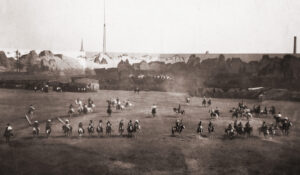Long Day’s Journey: The Steamboat & Stagecoach Era in the Northern West, by Carlos Arnaldo Schwantes, Gibbs-Smith, Salt Lake City, 1999, $60.
Having had much success with his 1993 book Railroad Signatures Across the Pacific Northwest, University of Idaho history professor Carlos Arnaldo Schwantes decided to focus on a couple of other means of transportation–namely, steamboats and stagecoaches. That was a good idea. Anyone who has a fascination for frontier transportation or who has spent time in the northern West (Oregon, Washington, Idaho, Montana and Wyoming) will be captivated by the nice blend of illustrations and text in this 408-page volume. For other readers, Long Day’s Journey is liable to lead to further study of transportation history and maybe even to a trip to that part of the country–even if by car or plane rather than steamboat or stage.
A small side-wheeler named Beaver, built in London and purchased by the Hudson’s Bay Company, first fired up her boilers on the Columbia River at Fort Vancouver in May 1836, and the age of steam had begun in the Pacific Northwest. Steam power had already arrived on the upper Missouri River by that time, but, because of shallow water, the first steamboat did not reach Fort Benton (in what would become Montana) until 1860. Soon after that, Oregon Steam Navigation Company boats on the Columbia and a variety of steamers on the Missouri brought streams of would-be miners into the interior when Rocky Mountain gold fever hit.
Still, steamboats could not take gold seekers everywhere they wanted to go. By 1864, stages were operating from Columbia River towns such as Umatilla and Wallula to inland towns such as Walla Walla and Lewiston. Ben Holladay, “the Stagecoach King,” made runs to the gold country from Salt Lake City after observing the success of A.J. Oliver and Company’s stage line. The first reliable public transportation from Fort Benton to the diggings at Helena was a stagecoach service started by C.C. Huntley in 1866. His success attracted the interest of Wells, Fargo. The era of steamers and stages in the northern West had just begun.
Schwantes continues the story to the turn of the 20th century, describing the entrepreneurs and transportation companies that rose and fell, examining the distances and rugged terrain that challenged the employees and passengers on steamers and stages, and providing contemporary accounts of commercial transportation. Even when the railroads came to move people and freight more quickly, there was a place for stage lines and steamboats in this vast region…at least for a while. “As late as the 1890s,” Schwantes writes, “there were still hundreds of small stage lines serving the remote settlements across the northern West. Thus horse-drawn coaches disappeared only gradually, in some places yielding to the new ‘automobile stages’ only in the early twentieth century.” This book makes you wish you were bouncing inside one of those Concord coaches on the road to new hope, or better yet, standing on an open-air deck of a side-wheel (or stern-wheel) steamer as it carries you closer to golden riches and opportunities.
Alexander Cook




